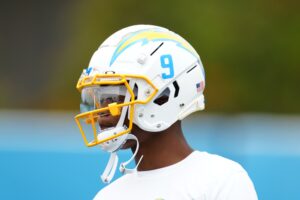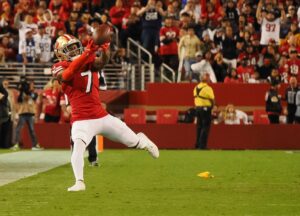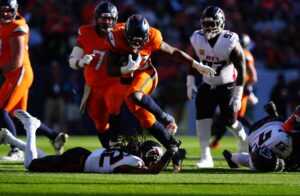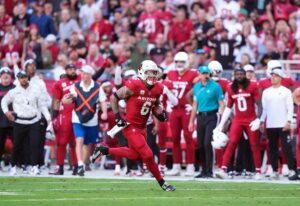Each year, heading into draft season, we start to settle upon players we love and players we hate, relative to ADP. This article will dive into the latter portion, my fantasy football fades. We never like to see players perform poorly, but we also need to identify players that look to be in disadvantageous situations. These are players that I won’t have on many of my teams this season if any at all.
Fantasy Football Fades for 2020
Before we get into these fantasy football fades, I want to preface this by saying that all of these are relative to ADP. Of course, if any of them slip a few rounds, I’ll take a chance on them but that rarely happens. These are all based on Fantasypros PPR ADP data as of this writing.
1. Devin Singletary
Devin Singletary is perhaps my the top of my fantasy football fades in 2020. It all comes down to how many “high value” touches he sees in 2020 and I’m not expecting very many. High-value touches I consider receptions and touches in the red zone. Singletary saw a decent amount of pass-game usage once he took over as the lead back, however, he was ranked as the 4th worst running back in the league according to Football Outsider’s DVOA rating.
In comes rookie Zack Moss, who was a great receiver in college. He’s also a much bigger and more bruising back, built better for a goal-line role. Quarterback, Josh Allen checked down to the running back at the lowest rate in the NFL in 2019 and is also a big threat to vulture touchdowns as well. With Zack Moss and Josh Allen both around, I don’t see Singletary returning great value at his current ADP of 49th overall. He’s going ahead of players like DJ Chark, Tyler Lockett, and Kareem Hunt, all of whom I would rather draft.
The Singletary truthers gonna hate me for this one but 🤷♂️ #FantasyFootball @MyFantasyLeague pic.twitter.com/yGOtw4oST4
— ✴️Rob Norton✴️ (@norton0723) July 25, 2020
2. Austin Hooper
Hooper had an amazing start to 2019. Before going down with an injury, he was one of the best tight ends in fantasy football. Even despite missing three games, Hooper still finished as the TE6 in PPR points and vaults up to the TE3 in PPR points per game. He also ranked fifth in receptions and sixth in targets among all tight ends in 2019. If Hooper wouldn’t have switched teams, I’d be all in for 2020. Alas, Hooper signed with the Cleveland Browns in the offseason and killed my interest in him as a fantasy option.
It was a good signing from a real-life perspective however, going from the Falcons to the Browns is a huge downgrade. Atlanta is likely to be near the league lead in pass attempts while Cleveland is likely to be near the bottom of the league. I can’t see Hooper commanding a higher target share, which is what he’d need to do to come anywhere near last year’s production. Currently going as the TE12 in PPR ADP, I’d much rather take a shot on the upside of Hayden Hurst, T.J. Hockenson, Mike Gesicki, or even Chris Herndon, all of whom are going after Hooper.
3. Cooper Kupp
Kupp, like Hooper, started out on fire in 2019. He was fresh off recovering from a torn ACL and was defying the odds on his way to being one of the best wide receivers in fantasy football. In the first eight games, Kupp totaled 87 targets, 58 receptions, 792 yards, and five touchdowns. After the bye, over the next eight games, he was only able to total 47 targets, 36 receptions, 369 yards, and five touchdowns. That’s an extremely concerning drop that also saw him see a big drop in his snap count as well.
This directly coincided with a big scheme change in which the Rams used more 12 personnel. This doesn’t suit Kupp’s game well as he’s a great slot receiver but struggles when asked to block and when asked to move outside and face more press coverage. With the Rams and Jared Goff having so much success under the new scheme, I’m expecting them to stick with it moving forward and that’s a huge concern for Kupp in 2020.
4. Amari Cooper
Amari Cooper is another guy coming off a great 2019. He finished with 75 receptions for 1,005 yards and seven touchdowns. It wasn’t always pretty as Amari is very inconsistent on a week-to-week basis, but it allowed him to finish as the WR10 in PPR points and WR14 in PPR points per game. His quarterback, Dak Prescott, also had 4,902 passing yards so you’d think everything looks great for a repeat in 2020. There’s a couple of concerns when looking forward for Amari.
First, I think it’s much more likely that Dak throws for less than 4,900 yards than more. Second, while they lost Randall Cobb and Jason Witten, they have CeeDee Lamb and Blake Jarwin replacing them, both of which are more explosive and should command more targets and put up more yards, thus leaving less for Cooper. Finally, and most importantly, is that teammate Michael Gallup put up almost the same exact PPR points per game and can be drafted multiple rounds later. Cooper will be solid and a weekly starter but is currently being drafted as the PPR WR14 ahead of guys like Calvin Ridley, Robert Woods, and DJ Chark, all of whom I would much rather draft.
If I've said it once, I've said it 100 times… 👀 (Except Gallup can be had 3+ rounds later) pic.twitter.com/EnJ34645wE
— ✴️Rob Norton✴️ (@norton0723) September 10, 2020
5. Mark Ingram
Last year I was all over Mark Ingram as a great value pick. He was going from New Orleans, where he was part of a committee, to Baltimore, where he looked like he would assume a lead role in a great offense. All of that came to fruition as Baltimore led the NFL in rushing and Ingram finished with 1,018 rushing yards, 26 receptions, 247 receiving yards, and 15 total touchdowns. That allowed him to finish as the RB11 in PPR points and RB10 in PPR points per game.
Looking towards 2020, he’s likely due some touchdown regression. He also wasn’t used a ton in the passing game as quarterback Lamar Jackson takes off running more than dumping down to the running back. The Ravens also drafted J.K. Dobbins who should siphon off some of the workload. Ingram should continue his efficient ways, however, with a dip in both volume and touchdowns, it might be tough to return good value at his current RB24 ADP. I think he is properly valued in comparison to other running backs, but this is more of a roster construction issue. I’d much rather take two running backs early and take a wide receiver such as DeVante Parker, Tyler Boyd, Michael Gallup, or even teammate Marquise Brown instead of Ingram.
6. Mike Evans
Evans is the name that makes me the most nervous on this list of fantasy football fades. Only Evans and Randy Moss have ever started their careers with six straight 1,000+ yard seasons. When you’ve done something that only Randy Moss has ever done, it’s risky business to fade a player that good, but here we are. Evans posted 67 receptions, 1,157 yards, and eight touchdowns in 2020 despite missing three games. He was the WR5 in PPR points per game. A lot has changed heading into 2020.
While Evans has been great, he’s also had the benefit of playing with quarterbacks who have been extremely aggressive in forcing the ball to him. This year, he has Tom Brady at the helm. Brady, at this point in his career, relies more upon underneath, conservative passing which doesn’t necessarily bode well for Evans. Tampa also brought in Rob Gronkowski who should be a threat, especially in the red zone. Jameis Winston threw for over 5,100 yards last year and if the Bucs are a better team this year, Brady is much more likely to be closer to 4,400. Evans will be an every-week starter for your fantasy team, however, at his current WR8 ADP, I’d much rather draft target hogs like D.J. Moore, Allen Robinson, or Adam Thielen, all of whom are being drafted after Evans.
7. Todd Gurley
Another year, another Todd Gurley “do not draft” recommendation from me. This makes two straight years that I’ve had Gurley on my list of fantasy football fades. Last year it started off looking great and then Gurley turned it on a bit as the season went on. Even still, Gurley finished as the RB16 in PPR points per game in 2020 which was below where he was being drafted. His value was salvaged by his 14 total touchdowns as he finished with the lowest rushing yardage (857) of his career. His efficiency also dipped to 3.8 YPC. Gurley also had his lowest receiving total (207) since his rookie year. All of this got cut by the Rams in the offseason.
He landed in Atlanta, which looks to be a great landing spot. Atlanta is a high powered offense and they threw to former running back, Devonta Freeman, a lot. Gurley is such a tough case and as such, is extremely divisive. Some analysts have him as a top-eight running back option while some have him well outside the top 20. Ultimately, if Gurley stays healthy all year, he’ll probably finish as a top 20 running back. The big concern, however, is the health of his knees. There were plenty of times in 2019 where you can see he wasn’t cutting the way he used to and that’s not something I’m looking to invest in especially ahead of guys like Allen Robinson, Adam Thielen, or James Conner.
Todd Gurley
2019:
Rams: 6th Most Run Heavy team in RZGurley: 3rd Most RZ carries (51)
———————————————
ATL: 7th Most Pass Heavy team in RZFreeman: 20 RZ carries in 1 less gm played
———————————————Gurley’s a Trap in the 3rd I’ll Avoid.https://t.co/T5jLDrS1hr
— Derek Brown (aka Ugly John Daigle) (@DBro_FFB) August 11, 2020
8. Stefon Diggs
This is the name that pains me the most to include on my list of fantasy football fades because Diggs is one of my favorite players in the NFL. Diggs is one of the best route runners in the league. He finally had a breakout season in 2018 when he posted a 102/1,021/9 line on 149 targets and I finally thought he was bound to see the high target totals yearly that he should be seeing. Diggs took a step back in 2019 when his target total dropped to 94 and his reception total dropped to 63. He was, however, able to improve his yardage total to 1,130 as he was one of the league’s premier deep threats on a run-heavy offense.
In 2020 he’s going from one run-heavy offense in Minnesota to another run-heavy offense in Buffalo. The problem is that he’s going from one of the most efficient deep passers (Kirk Cousins) to one of the least efficient deep passers (Josh Allen). It’s unlikely that he sees a big boost in target volume and even if it’s a slight boost, the quality of those targets will not be as good. I’m expecting the yards per reception to come down a bit as well. For a guy that finished WR25 in PPR points per game, and being drafted right around there again (WR27), I don’t see an easy path to a big boost in receptions and yards for him to make a jump back up closer to 2018 numbers.
9. Raheem Mostert
Fading Shanahan running backs usually is not a wise choice. Over the years, both Kyle and his father, Mike, have become the running back whisperers. Any running back in their systems has become a very good fantasy option. So why am I fading Mostert? There are some major red flags in this situation. First, Mostert isn’t used very often in the passing game. He only caught 14 passes last year. That makes him very touchdown dependent with a low weekly floor. Second is that despite balling out down the stretch in 2019, Mostert barely saw more than half the snaps. He also only had one game in which he had more than 14 carries in a single game.
Shanahan notoriously rides the hot hand on a game-to-game basis and that’s a big concern. Teammates Tevin Coleman and Jerick McKinnon could easily lead the team in touches any given week and are especially more likely to see a higher percentage of the receiving work. All of these concerns, combined with roster construction, have me avoiding Mostert at 60th overall in ADP, instead targeting Coleman and McKinnon rounds later.
10. Aaron Rodgers
Oh, how the mighty have fallen. Rodgers was one of the elite quarterbacks in fantasy every single year for nearly a decade. Between 2008 and 2016, he finished QB1 or QB2 seven times in nine seasons. While he’s still been a top ten option the past two years, we’ve started to see signs of decline. Rodgers has still limited the interceptions as he has only six COMBINED over the past two years, but the big dip has been in his touchdown percentage.
His career number is 6% and was even higher before last year’s 4.6% and 4.2% in 2018. He’s become too risk-averse. He also doesn’t have the volume to make up for it as Green Bay has become more run-heavy recently. That seems likely to continue in 2020. He also doesn’t give you the 250-350 rushing yards he used to either. Rodgers will have his moments, but as a conservative quarterback in a run-heavy offense without a rushing element to his game, count me out.
Through Week 16 (typical fantasy season) in 2019, Aaron Rodgers was a Top-12 QB only 5 times (33%).
He had just as many games @ or under 15 FPs, including four under 13 FPs.
How has his situation improved in 2020? Why is he QB8 in FantasyPros ADP?
— Wolf of Roto Street (@RotoStreetWolf) June 29, 2020
Main photo:
Embed from Getty Images






